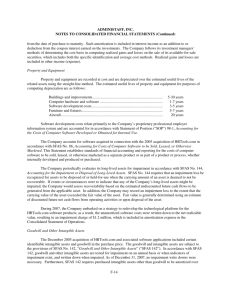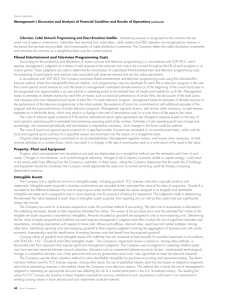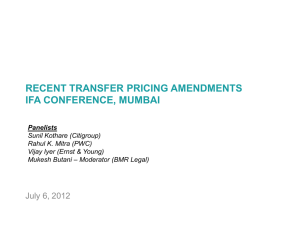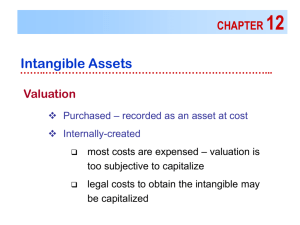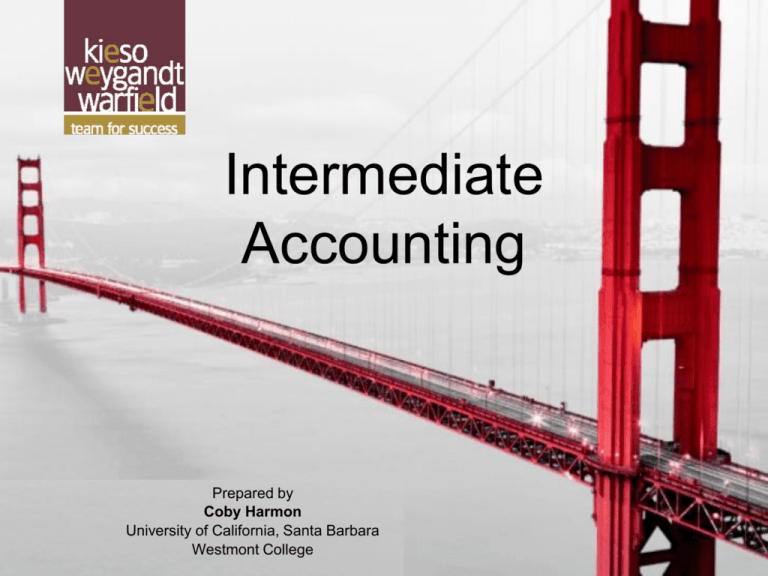
Intermediate
Intermediate
Accounting
Accounting
12-1
Prepared by
Prepared by
Coby Harmon
Harmon
University of California, Santa Coby
Barbara
University of California, Santa Barbara
Westmont College
12
Intangible Assets
LEARNING OBJECTIVES
After studying this chapter, you should be able to:
1. Describe the characteristics of intangible
assets.
6. Explain the accounting issues related to
intangible-asset impairments.
2. Identify the costs to include in the initial
valuation of intangible assets.
7. Identify the conceptual issues related to
research and development costs.
3. Explain the procedure for amortizing
intangible assets.
8. Describe the accounting for research and
development and similar costs.
4. Describe the types of intangible assets.
9. Indicate the presentation of intangible
assets and related items.
5. Explain the accounting issues for
recording goodwill.
12-2
PREVIEW OF CHAPTER 12
Intermediate Accounting
15th Edition
Kieso Weygandt Warfield
12-3
INTANGIBLE ASSET ISSUES
Characteristics
1. Lack physical existence.
2. Not financial instruments.
3. Non-current (normally a long-term asset)
Common types of intangibles:
12-4
Patents
Trademarks or trade names
Copyrights
Goodwill
Franchises or licenses
LO 1 Describe the characteristics of intangible assets.
Importance of Intangible Assets
Cola Company’s
success comes from its
secret formula for
making Coca-Cola, not
its plant facilities.
Dropped below
50% in the last
few years makes stock
values more
volatile
12-5
In life, intangibles often
have much greater
meaning and value than
tangibles do:
-health
-family
-freedom
-security
Importance of Intangible Assets
Quote from Alan Greenspan:
“… a firm is inherently fragile if its value-added
emanates more from conceptual as distinct
from physical assets. Trust and reputation
can vanish overnight. A factory cannot.”
E.g. within a few days, Enron lost most of its
market value
12-6
INTANGIBLE ASSET ISSUES
Valuation
Purchased Intangibles
12-7
Recorded at cost.
Includes all costs necessary to make the intangible asset
ready for its intended use.
Typical costs include:
►
Purchase price.
►
Legal fees.
►
Other incidental expenses.
LO 2 Identify the costs to include in the initial valuation of intangible assets.
INTANGIBLE ASSET ISSUES
Valuation
Internally Created Intangibles
Generally expensed.
Only capitalize direct costs
incurred in developing the
intangible, such as legal costs.
Google expensed the R&D costs incurred to develop its
valuable search engine.
12-8
LO 2 Identify the costs to include in the initial valuation of intangible assets.
INTANGIBLE ASSET ISSUES
Amortization of Intangibles
Limited-Life Intangibles
12-9
Amortize by systematic charge to expense over useful life.
Credit asset account or accumulated amortization
(preferred).
Useful life should reflect the periods over which the asset
will contribute to cash flows.
Amortization should be cost less residual value.
Companies should evaluate the limited-life intangibles for
impairment.
LO 3 Explain the procedure for amortizing intangible assets.
INTANGIBLE ASSET ISSUES
Amortization of Intangibles
Indefinite-Life Intangibles
12-10
No foreseeable limit on time the asset is expected to
provide cash flows.
Must test indefinite-life intangibles for impairment at least
annually.
No amortization.
LO 3 Explain the procedure for amortizing intangible assets.
INTANGIBLE ASSET ISSUES
Amortization of Intangibles
12-11
ILLUSTRATION 12-1
Accounting Treatment
for Intangibles
LO 3 Explain the procedure for amortizing intangible assets.
The importance of intangible asset
classification as either limited-life or
indefinite-life is illustrated in the experience
of Outdoor Channel Holdings. Here’s what
happened. Outdoor Channel recorded an
intangible asset related to the value of an
important distributor relationship, purchased
from another company. At that time, it
classified the relationship as indefinite-life.
Thus, in the first two years of the
asset’s life, Outdoor Channel recorded no
amortization expense on this asset. In the
third year, investors were surprised
to find that Outdoor Channel changed the
classification of the distributor relationship to
limited-life, with an expected life of 21.33
years (a fairly definite useful life) and,
shortly thereafter, wrote off this intangible
completely.
12-12
Apparently, the company was overly
optimistic about the expected future cash
flows arising from the distributor
relationship. As a result of that optimism,
income in the second year was
overstated by $9.5 million, or 14 percent,
and the impairment recorded in the third
year amounted to 7 percent of assets.
From indefinite-life to limited-life to
worthless in two short years—investors
were surely hurt by Outdoor’s aggressive
intangible asset classification.
Source: Jack Ciesielski, The AAO
Weblog, www.accountingobserver.
com/blog/ (January 12, 2007).
LO 3 Explain the procedure for amortizing intangible assets.
TYPES OF INTANGIBLE ASSETS
Six Major Categories:
12-13
(1) Marketing-related.
(4) Contract-related.
(2) Customer-related.
(5) Technology-related.
(3) Artistic-related.
(6) Goodwill.
LO 4 Describe the types of intangible assets.
TYPES OF INTANGIBLE ASSETS
Marketing-Related Intangible Assets
Examples:
►
12-14
Trademarks or trade names, newspaper
mastheads, Internet domain names, and noncompetition agreements.
In the United States trademarks or trade names have
legal protection for indefinite number of 10 year
renewal periods.
Capitalize acquisition costs.
No amortization due to indefinite life.
LO 4 Describe the types of intangible assets.
Trademarks
12-15
15
TYPES OF INTANGIBLE ASSETS
Customer-Related Intangible Assets
Examples:
►
12-16
Customer lists, order or production backlogs, and both
contractual and non-contractual customer relationships. A
common example created in the sale of a business is a
covenant not to compete.
Capitalize acquisition costs.
Amortized to expense over useful life.
LO 4 Describe the types of intangible assets.
TYPES OF INTANGIBLE ASSETS
Illustration: Green Market Inc. acquires the customer list of a large
newspaper for $6,000,000 on January 1, 2014. Green Market
expects to benefit from the information evenly over a three-year
period. Record the purchase of the customer list and the
amortization of the customer list at the end of each year.
12-17
Jan. 1
2014
Customer List
Dec. 31
2014
2015
2016
Amortization Expense
6,000,000
Cash
Customer List *
* or Accumulated Amortization
6,000,000
2,000,000
2,000,000
LO 4 Describe the types of intangible assets.
TYPES OF INTANGIBLE ASSETS
Artistic-Related Intangible Assets
Examples:
►
Copyright granted for the life of the creator plus 70 years.
12-18
Plays, literary works, musical works, pictures,
photographs, and video and audiovisual material.
The Copyright Term Extension Act of 1988 added 20 years. Also
known as the Mickey Mouse Protection Act because Disney lobbied
for the extension due to the expiration of Mickey
Capitalize costs of acquiring and defending.
Amortized to expense over useful life.
LO 4
TYPES OF INTANGIBLE ASSETS
Contract-Related Intangible Assets
Examples:
►
12-19
Franchise and licensing agreements, construction
permits, broadcast rights, and service or supply contracts.
Franchise (or license) with a limited life should be
amortized to expense over the life of the franchise.
Franchise with an indefinite life should be carried at cost
and not amortized.
LO 4
Franchises and Licenses
A franchise is a contractual agreement under which the
franchiser grants the franchisee the right (within a
designated geographic area)
12-20
to sell certain products (e.g. Toyota Dealership, Taco Bell)
to render specific services, or (e.g. Curves for Women)
to use certain trademarks or trade names
When costs can be identified with the acquisition of the
franchise or license, an intangible asset should be
recognized
Annual payments made under a franchise agreement
should be recorded as operating expenses
See http://www.thefranchisemall.com/
20
12-21
TYPES OF INTANGIBLE ASSETS
Technology-Related Intangible Assets
Examples:
►
12-22
Patented technology and trade secrets granted by the
U.S. Patent and Trademark Office.
Patent gives holder exclusive use for a period of 20 years.
Capitalize costs of purchasing a patent.
Expense any R&D costs in developing a patent.
Amortize over legal life or useful life, whichever is shorter.
LO 4 Describe the types of intangible assets.
PATENT BATTLES
From online retailing to cell phone features,
global competition is bringing to the boiling
point battles over patents. For example, to
protect its patented “one-click” shopping
technology that saves your shipping and
credit card information when you shop
online, Amazon.com filed a complaint
against Barnesandnoble.com, its rival in the
e-tailing wars. The smartphone industry is
another patent battleground. For example,
Nokia fi led patent lawsuits against
Apple (and Apple countersued) over cell
phone features such as swiping gestures on
touch screens and the ”app store” for
downloading software. Apple also targeted
HTC
12-23
for infringing on Apple’s patented feature
that allows screens to detect more than
one finger touch at a time. This
facilitates the popular zoom-in and –out.
HTC, in turn, sued Apple for infringing on
patented technology that helps extend
battery life.
Source: Adapted from L. Rohde,
“Amazon, Barnes and Noble
Settle Patent Dispute,” CNN.com (March
8, 2002); and J. Mintz, “Smart Phone
Makers in Legal Fights over Patents,”
Wisconsin State Journal (December 19,
2010), p. F4.
LO 3 Explain the procedure for amortizing intangible assets.
TYPES OF INTANGIBLE ASSETS
Illustration: Harcott Co. incurs $180,000 in legal costs on January
1, 2014, to successfully defend a patent. The patent’s useful life is
20 years, amortized on a straight-line basis. Harcott records the
legal fees and the amortization at the end of 2014 as follows.
Jan. 1
Patents
180,000
Cash
Dec. 31
Amortization Expense
180,000
9,000
Patents (or Accumulated Amortization)
12-24
9,000
LO 4 Describe the types of intangible assets.
SECRET FORMULA
After several espionage cases were
uncovered, the secrets contained within the
Los Alamos nuclear lab seemed easier
to check out than a library book. But The
Coca-Cola Company has managed to keep
the recipe for the world’s best-selling soft
drink under wraps for more than 100 years.
The company offers almost no information
about its lifeblood, and the only written copy
of the formula resides in a bank vault in
Atlanta. This handwritten sheet is available
to no one except by vote of Coca-Cola’s
board of directors. Can’t science offer some
clues? Coke purportedly contains 17 to 18
ingredients. That includes the usual caramel
color and corn syrup, as well as a blend of
oils known as 7X (rumored to be a mix of
orange, lemon, cinnamon, and
12-25
others). Distilling natural products like
these is complicated since they are made
of thousands of compounds. One
ingredient you will not find, by the way, is
cocaine. Although the original formula did
contain trace amounts, today’s Coke
doesn’t. When was it removed? That too
is a secret. Some experts indicate that
the power of the Coca-Cola formula
and related brand image account for
almost $72 billion, or roughly 6 percent, of
Coke’s $1,128 billion stock value.
Source: Adapted from Reed Tucker, “How
Has Coke’s Formula Stayed a Secret?”
Fortune (July 24, 2000), p. 42; and “Best
Global Brands 2011,”
www.interbrand.com (accessed July 5,
2012).
LO 4 Describe the types of intangible assets.
TYPES OF INTANGIBLE ASSETS
Goodwill
Conceptually, represents the future economic benefits arising
from the other assets acquired in a business combination that
are not individually identified and separately recognized.
Only recorded when an entire business is purchased.
Goodwill is measured as the excess of ...
cost of the purchase over the FMV of the identifiable net assets
(assets less liabilities) purchased.
Internally created goodwill should not be capitalized.
12-26
LO 5 Explain the accounting issues for recording goodwill.
In 2005, Proctor &
Gamble paid $57 billion
for Gillette, when the
Gillette brand was valued
at only $24 billion. This
created goodwill of $33
billion on P&G’s balance
sheet, which must be
assessed for impairment
in value every year.
How to determine value is
very tricky and
subjective, as can be
seen in the wide
differences in appraised
values of the brand by
three leading appraisers.
12-27
12-28
RECORDING GOODWILL
Illustration: Multi-Diversified, Inc. decides that it needs a parts
division to supplement its existing tractor distributorship. The
president of Multi-Diversified is interested in buying Tractorling
Company. The illustration presents the statement of financial position
of Tractorling Company.
ILLUSTRATION 12-3
12-29
LO 5 Explain the accounting issues for recording goodwill.
RECORDING GOODWILL
Illustration: Multi-Diversified investigates Tractorling’s underlying
assets to determine their fair values.
ILLUSTRATION 12-4
Tractorling Company decides to accept Multi-Diversified’s offer of
$400,000. What is the value of the goodwill, if any?
12-30
LO 5 Explain the accounting issues for recording goodwill.
RECORDING GOODWILL
Illustration: Determination of Goodwill.
ILLUSTRATION 12-5
12-31
LO 5 Explain the accounting issues for recording goodwill.
RECORDING GOODWILL
Illustration: Multi-Diversified records this transaction as follows.
Cash
25,000
Accounts Receivables
35,000
Inventory
122,000
Property, Plant, and Equipment
205,000
Patents
18,000
Goodwill
50,000
Liabilities
Cash
12-32
55,000
400,000
LO 5 Explain the accounting issues for recording goodwill.
RECORDING GOODWILL
Example: Global Corporation purchased the net assets of Local
Company for $300,000 on December 31, 2014. The balance sheet of
Local Company just prior to acquisition is:
Assets
Cash
Receivables
Inventories
Equipment
Total
$
$
Liabilities and Equities
Accounts payable
Common stock
Retained earnings
Total
12-33
$
$
Cost
15,000
10,000
50,000
80,000
155,000
25,000
100,000
30,000
155,000
$
FMV
15,000
10,000
70,000
130,000
225,000
$
25,000
$
25,000
$
FMV of Net
Assets =
$200,000
LO 5 Explain the accounting issues for recording goodwill.
RECORDING GOODWILL
Example: Global Corporation purchased the net assets of Local
Company for $300,000 on December 31, 2014. The value assigned to
goodwill is determined as follows:
Book Value = $130,000
Revaluation
$70,000
Fair Value = $200,000
Goodwill
$100,000
Purchase Price = $300,000
12-34
LO 5 Explain the accounting issues for recording goodwill.
RECORDING GOODWILL
Example: Global Corporation purchased the net assets of Local
Company for $300,000 on December 31, 2014. The value assigned to
goodwill is determined as follows:
Calculation of Goodwill:
Cash
15,000
Receivables
10,000
Inventories
70,000
Equipment
130,000
Accounts payable
(25,000)
FMV of identifiable net assets
200,000
Purchase price
300,000
Goodwill
12-35
$
$
100,000
LO 5 Explain the accounting issues for recording goodwill.
RECORDING GOODWILL
Example: Global Corporation purchased the net assets of Local
Company for $300,000 on December 31, 2014. Prepare the journal entry
to record the purchase of the net assets of Local.
Journal entry recorded by Global:
Cash
15,000
Receivables
10,000
Inventory
70,000
Equipment
130,000
Goodwill
100,000
Accounts payable
Cash
12-36
25,000
300,000
LO 5 Explain the accounting issues for recording goodwill.
RECORDING GOODWILL
Goodwill Write-Off
Goodwill considered to have an indefinite life.
Should not be amortized.
Only adjust carrying value when goodwill is impaired.
Bargain Purchase
12-37
Purchase price less than the fair value of net assets
acquired.
Amount is recorded as a gain by the purchaser.
LO 5 Explain the accounting issues for recording goodwill.
IMPAIRMENT OF INTANGIBLE ASSETS
Impairment of Limited-Life Intangibles
Same as impairment for long-lived assets in Chapter 11.
1. If the sum of the expected future net cash flows (undiscounted) is
less than the carrying amount of the asset, an impairment has
occurred (recoverability test).
2. The impairment loss is the amount by which the carrying amount
of the asset exceeds the fair value of the asset (fair value test).
The loss is reported as part of income from continuing
operations, “Other expenses and losses” section.
12-38
LO 6 Explain the accounting issues related to intangible-asset impairments.
IMPAIRMENT OF INTANGIBLE ASSETS
Illustration: Lerch, Inc. has a patent on how to extract oil from shale
rock. Unfortunately, several recent non-shale oil discoveries adversely
affected the demand for shale-oil technology. As a result, Lerch
performs a recoverability test. It finds that the expected future net
cash flows from this patent are $35 million. Lerch’s patent has a
carrying amount of $60 million. Discounting the expected future net
cash flows at its market rate of interest, Lerch determines the fair
value of its patent to be $20 million. Perform the recoverability test.
12-39
Expected future net cash flows
Carrying value
$
35,000,000
60,000,000
Asset impaired
$ (25,000,000)
LO 6 Explain the accounting issues related to intangible-asset impairments.
IMPAIRMENT OF INTANGIBLE ASSETS
Illustration: Perform the fair value test and the journal entry (if any)
to record the impairment of the asset.
Carrying amount of patent
$
Fair value
20,000,000
Loss on impairment
Loss on impairment
Patents
60,000,000
$
40,000,000
40,000,000
40,000,000
Companies may not recognize restoration of the previously recognized
impairment loss.
12-40
LO 6 Explain the accounting issues related to intangible-asset impairments.
IMPAIRMENT OF INTANGIBLE ASSETS
Impairment of Indefinite-Life Intangibles Other
than Goodwill
12-41
Should be tested for impairment at least annually.
Impairment test is a fair value test.
►
If the fair value of asset is less than the carrying
amount, an impairment loss is recognized for the
difference.
►
Recoverability test is not used.
LO 6 Explain the accounting issues related to intangible-asset impairments.
IMPAIRMENT OF INTANGIBLE ASSETS
Illustration: Arcon Radio purchased a broadcast license for
$2,000,000. Arcon Radio has renewed the license with the FCC
twice, at a minimal cost. Because it expects cash flows to last
indefinitely, Arcon reports the license as an indefinite-life intangible
asset. Recently the FCC decided to auction these licenses to the
highest bidder instead of renewing them. Arcon Radio expects cash
flows for the remaining two years of its existing license. It performs an
impairment test and determines that the fair value of the intangible
asset is $1,500,000.
ILLUSTRATION 12-7
12-42
LO 6 Explain the accounting issues related to intangible-asset impairments.
IMPAIRMENT OF INTANGIBLE ASSETS
Impairment of Goodwill
Two Step Process:
Step 1: If fair value is less than the carrying amount of the net
assets (including goodwill), then perform a second step
to determine possible impairment.
Step 2: Determine the fair value of the goodwill (implied value of
goodwill) and compare to carrying amount.
12-43
LO 6 Explain the accounting issues related to intangible-asset impairments.
IMPAIRMENT OF INTANGIBLE ASSETS
Illustration: Kohlbuy Corporation has three divisions. It purchased one
division, Pritt Products, four years ago for $2 million. Kohlbuy
management is now reviewing the division for purposes of recognizing an
impairment. Illustration 12-8 lists the Pritt Division’s net assets, including
the associated goodwill of $900,000 from the purchase.
ILLUSTRATION 12-8
Assume that the fair value of the Pritt Division is $1,900,000.
12-44
LO 6
IMPAIRMENT OF INTANGIBLE ASSETS
Illustration: Prepare the journal entry (if any) to record the impairment.
ILLUSTRATIONS 12-9 and 12-10
Step 1: The fair value
of the reporting unit is
below its carrying
value. Therefore, an
impairment has
occurred.
Loss on impairment
Goodwill
12-45
Step 2:
Fair value
Carrying amount, net of goodwill
Implied goodwill
Carrying value of goodwill
Loss on impairment
$
$
1,900,000
1,500,000
400,000
900,000
(500,000)
500,000
500,000
LO 6 Explain the accounting issues related to intangible-asset impairments.
IMPAIRMENT OF INTANGIBLE ASSETS
Impairment Summary
ILLUSTRATION 12-11
12-46
LO 6 Explain the accounting issues related to intangible-asset impairments.
IMPAIRMENT RISK
As shown in the chart below, goodwill impairments spiked in 2008 and 2009, coinciding
with the stock market downturn in the wake of the financial crisis.
12-47
LO 6 Explain the accounting issues related to intangible-asset impairments.
RESEARCH AND DEVELOPMENT COSTS
Identifying R & D Activities
ILLUSTRATION 12-13
Research Activities
Planned search or critical investigation
aimed at discovery of new knowledge.
Development Activities
Translation of research findings or other
knowledge into a plan or design for a
new product or process or for a
significant improvement to an existing
product or process whether intended for
sale or use.
12-48
Examples
Laboratory research aimed at discovery of
new knowledge; searching for applications of
new research findings.
Examples
Conceptual formulation and design of
possible product or process alternatives;
construction of prototypes and
operation of pilot plants.
LO 7 Identify the conceptual issues related to research and development costs.
RESEARCH AND DEVELOPMENT COSTS
Research and development (R&D) costs are not in
themselves intangible assets.
Frequently results in something that a company patents or
copyrights such as:
new product,
formula,
process,
composition, or
idea,
literary work.
Companies must expense all research and development costs
when incurred.
12-49
LO 7 Identify the conceptual issues related to research and development costs.
RESEARCH AND DEVELOPMENT COSTS
Companies spend considerable sums on research and
development.
ILLUSTRATION 12-12
12-50
LO 7 Identify the conceptual issues related to research and development costs.
RESEARCH AND DEVELOPMENT COSTS
Accounting for R & D Activities
Costs Associated with R&D Activities:
12-51
Materials, Equipment, and Facilities.
Personnel.
Purchased Intangibles.
Contract Services.
Indirect Costs.
LO 8 Describe the accounting for research and development and similar costs.
RESEARCH AND DEVELOPMENT COSTS
E12-1: Indicate how items on the list below would generally be reported in
the financial statements.
Item
1.
Investment in a subsidiary company.
2.
Timberland.
3.
Cost of engineering activity required to
advance the design of a product to the
manufacturing stage.
4.
Lease prepayment.
5.
Cost of equipment obtained.
6.
Cost of searching for applications of
new research findings.
12-52
Classification
??
LO 8
RESEARCH AND DEVELOPMENT COSTS
Item
7.
Cost incurred in the formation of a
corporation.
8.
Operating losses incurred in the
start-up of a business.
9.
Training costs incurred in start-up of
new operation.
Classification
10. Purchase cost of a franchise.
11. Goodwill generated internally.
12. Cost of testing in search of product
alternatives.
12-53
LO 8 Describe the accounting for research and development and similar costs.
RESEARCH AND DEVELOPMENT COSTS
Item
Classification
13. Goodwill acquired in the purchase
of a business.
14. Cost of developing a patent.
15. Cost of purchasing a patent from
an inventor.
16. Legal costs incurred in securing a
patent.
17. Unrecovered costs of a successful legal
suit to protect the patent.
12-54
LO 8 Describe the accounting for research and development and similar costs.
RESEARCH AND DEVELOPMENT COSTS
Item
Classification
18. Cost of conceptual formulation of
possible product alternatives.
19. Cost of purchasing a copyright.
20. Research and development costs.
21. Long-term receivables.
22. Cost of developing a trademark.
23. Cost of purchasing a trademark.
12-55
LO 8 Describe the accounting for research and development and similar costs.
RESEARCH AND DEVELOPMENT COSTS
Costs Similar to R & D Costs
12-56
Start-up costs for a new operation.
Initial operating losses.
Advertising costs.
Computer software costs.
LO 8 Describe the accounting for research and development and similar costs.
RESEARCH AND DEVELOPMENT COSTS
E12-17: Compute the amount to be reported as research and
development expense.
Cost of equipment acquired that will have alternative
uses in future R&D projects over the next 5 years.
Materials consumed in R&D projects
R&D?
$330,000
$??
59,000
Consulting fees paid to outsiders for R&D projects
100,000
Personnel costs of persons involved in R&D projects
128,000
Indirect costs reasonably allocable to R&D projects
50,000
Materials purchased for future R&D projects
34,000
$??
12-57
LO 8 Describe the accounting for research and development and similar costs.
BRANDED
For many companies, developing a strong brand
image is as important as developing the products
they sell. As the following chart indicates, the value
of brand investments is substantial. Coca-Cola
heads the list with an estimated brand value of
about $69 billion.
Occasionally you may find the value of a brand
included in a company’s financial statements
under goodwill. But generally you will not find
the estimated values of brands recorded in
companies’ balance sheets. The reason? The
subjectivity that goes into estimating a brand’s
value. In some cases, analysts base an
estimate of brand value on opinion polls or on
some multiple of ad spending. For example, in
estimating the brand values shown above,
Interbrand Corp. estimates the percentage of
the overall future revenues the brand will
generate and then discounts the net cash flows,
to arrive at a present value. Some analysts
believe that information on brand values is
relevant. Others voice valid concerns about the
reliability of brand value estimates due to
subjectivity in the estimates for revenues, costs,
and the risk component of the discount rate.
Source: “Best Global Brands 2011”
www.interbrand.com (accessed July 5, 2012).
12-58
LO 8 Describe the accounting for research and development and similar costs.
PRESENTATION OF INTANGIBLES
Presentation of Intangible Assets
Balance Sheet
12-59
Intangible assets shown as a separate item.
Reporting is similar to the reporting of property, plant, and
equipment.
Contra accounts are not normally shown for intangibles.
Companies should report as a separate item all intangible
assets other than goodwill.
LO 9 Indicate the presentation of intangible assets and related items.
PRESENTATION OF INTANGIBLES
Presentation of Intangible Assets and
Research and Development Costs
Income Statement
12-60
Report amortization expense and impairment losses in
continuing operations.
Total R&D costs charged to expense must be disclosed.
LO 9 Indicate the presentation of intangible assets and related items.
PRESENTATION OF INTANGIBLES
ILLUSTRATION 12-15
12-61
LO 9 Indicate the presentation of intangible assets and related items.
PRESENTATION OF INTANGIBLES
ILLUSTRATION 12-16
12-62
LO 9 Indicate the presentation of intangible assets and related items.
RELEVANT FACTS
12-63
Like GAAP, under IFRS intangible assets (1) lack physical substance and (2) are
not financial instruments. In addition, under IFRS an intangible asset is identifiable.
To be identifiable, an intangible asset must either be separable from the company
(can be sold or transferred) or it arises from a contractual or legal right from which
economic benefits will flow to the company. Fair value is used as the
measurement basis for intangible assets under IFRS, if it is more clearly evident.
IFRS and GAAP are very similar for intangibles acquired in a business
combination. That is, companies recognize an intangible asset separately from
goodwill if the intangible represents contractual or legal rights or is capable of
being separated or divided and sold, transferred, licensed, rented, or exchanged.
In addition, under both GAAP and IFRS, companies recognize acquired in-process
research and development (IPR&D) as a separate intangible asset if it meets the
definition of an intangible asset and its fair value can be measured reliably.
LO 10 Compare the accounting for intangible assets under GAAP and IFRS.
RELEVANT FACTS
12-64
IFRS permits revaluation on limited-life intangible assets. Revaluations are not
permitted for goodwill and other indefinite-life intangible assets.
IFRS permits some capitalization of internally generated intangible assets (e.g.,
brand value) if it is probable there will be a future benefit and the amount can be
reliably measured. GAAP requires expensing of all costs associated with internally
generated intangibles.
IFRS requires an impairment test at each reporting date for long-lived assets and
intangibles, and records an impairment if the asset’s carrying amount exceeds its
recoverable amount. The recoverable amount is the higher of the asset’s fair value
less costs to sell and its value-in-use. Value-in-use is the future cash flows to be
derived from the particular assets, discounted to present value. Under GAAP,
impairment loss is measured as the excess of the carrying amount over the
asset’s fair value.
LO 10 Compare the accounting for intangible assets under GAAP and IFRS.
RELEVANT FACTS
12-65
IFRS allows reversal of impairment losses when there has been a change in
economic conditions or in the expected use of limited-life intangibles. Under
GAAP, impairment losses cannot be reversed for assets to be held and used; the
impairment loss results in a new cost basis for the asset. IFRS and GAAP are
similar in the accounting for impairments of assets held for disposal.
Under IFRS, costs in the development phase of an research and development
project are capitalized once technological feasibility (referred to as economic
viability) is achieved.
LO 10 Compare the accounting for intangible assets under GAAP and IFRS.
ON THE HORIZON
The IASB and FASB have identified a project, in a very preliminary stage, which would
consider expanded recognition of internally generated intangible assets. As indicated,
IFRS permits more recognition of intangibles compared to GAAP. Thus, it will be
challenging to develop converged standards for intangible assets, given the longstanding prohibition on capitalizing intangible assets and research and development in
GAAP.
Learn more about the timeline for the intangible asset project at the IASB website
http://www.iasb.org/current_Projects/IASB_Projects/IASB_Work_Plan.htm.
12-66
LO 10 Compare the accounting for intangible assets under GAAP and IFRS.
IFRS SELF-TEST QUESTION
Research and development costs are:
a. expensed under GAAP.
b. expensed under IFRS.
c.
expensed under both GAAP and IFRS.
d. None of the above.
12-67
LO 10 Compare the accounting for intangible assets under GAAP and IFRS.
IFRS SELF-TEST QUESTION
A loss on impairment of an intangible asset under IFRS is the asset’s:
a. carrying amount less the expected future net cash flows.
b. carrying amount less its recoverable amount.
c.
recoverable amount less the expected future net cash flows.
d. book value less its fair value.
12-68
LO 10 Compare the accounting for intangible assets under GAAP and IFRS.
IFRS SELF-TEST QUESTION
Recovery of impairment is recognized for all the following except:
a. patent held for sale.
b. patent held for use.
c.
trademark.
d. goodwill.
12-69
LO 10 Compare the accounting for intangible assets under GAAP and IFRS.
COPYRIGHT
Copyright © 2013 John Wiley & Sons, Inc. All rights reserved.
Reproduction or translation of this work beyond that permitted in
Section 117 of the 1976 United States Copyright Act without the
express written permission of the copyright owner is unlawful.
Request for further information should be addressed to the
Permissions Department, John Wiley & Sons, Inc. The purchaser
may make back-up copies for his/her own use only and not for
distribution or resale. The Publisher assumes no responsibility for
errors, omissions, or damages, caused by the use of these
programs or from the use of the information contained herein.
12-70




